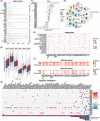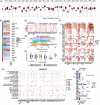Dissecting the role of cancer-associated fibroblast-derived biglycan as a potential therapeutic target in immunotherapy resistance: A tumor bulk and single-cell transcriptomic study
- PMID: 36772945
- PMCID: PMC9920016
- DOI: 10.1002/ctm2.1189
Dissecting the role of cancer-associated fibroblast-derived biglycan as a potential therapeutic target in immunotherapy resistance: A tumor bulk and single-cell transcriptomic study
Abstract
Introduction: Cancer-associated fibroblasts (CAFs) are correlated with the immunotherapy response. However, the culprits that link CAFs to immunotherapy resistance are still rarely investigated in real-world studies.
Objectives: This study aims to systematically assess the landscape of fibroblasts in cancer patients by combining single-cell and bulk profiling data from pan-cancer cohorts. We further sought to decipher the expression, survival predictive value and association with immunotherapy response of biglycan (BGN), a proteoglycan in the extracellular matrix, in multiple cohorts.
Methods: Pan-cancer tumor bulks and 27 single-cell RNA sequencing cohorts were enrolled to investigate the correlations and crosstalk between CAFs and tumor or immune cells. Specific secreting factors of CAFs were then identified by expression profiling at tissue microdissection, isolated primary fibroblasts and single-cell level. The role of BGN was further dissected in additional three bulk and five single-cell profiling datasets from immunotherapy cohorts and validated in real-world patients who have received PD-1 blockade using immunohistochemistry and immunofluorescence.
Results: CAFs were closely correlated with immune components. Frequent crosstalk between CAFs and other cells was revealed by the CellChat analysis. Single-cell regulatory network inference and clustering identified common and distinct regulators for CAFs across cancers. The BGN was determined to be a specific secreting factor of CAFs. The BGN served as an unfavourable indicator for overall survival and immunotherapy response. In the real-world immunotherapy cohort, patients with high BGN levels presented a higher proportion of poor response compared with those with low BGN (46.7% vs. 11.8%) and a lower level of infiltrating CD8+ T cells was also observed.
Conclusions: We highlighted the importance of CAFs in the tumor microenvironment and revealed that the BGN, which is mainly derived from CAFs, may be applicable in clinical practice and serve as a therapeutic target in immunotherapy resistance.
Keywords: tumor microenvironment; cancer-associated fibroblasts; immunotherapy; tumor biomarker.
© 2023 The Authors. Clinical and Translational Medicine published by John Wiley & Sons Australia, Ltd on behalf of Shanghai Institute of Clinical Bioinformatics.
Conflict of interest statement
No conflict of interest is declared.
Figures








References
Publication types
MeSH terms
Substances
Grants and funding
- 82003066/National Natural Science Foundation of China
- 2021YFE0206300/National Key Research and Development Program
- FDCT-0011/2019/AKP/The Science and Technology Development Fund, Macau SAR
- 0034/2019/AGJ/The Science and Technology Development Fund, Macau SAR
- 2022M720178/China Postdoctoral Science Foundation
LinkOut - more resources
Full Text Sources
Other Literature Sources
Medical
Research Materials
Miscellaneous
